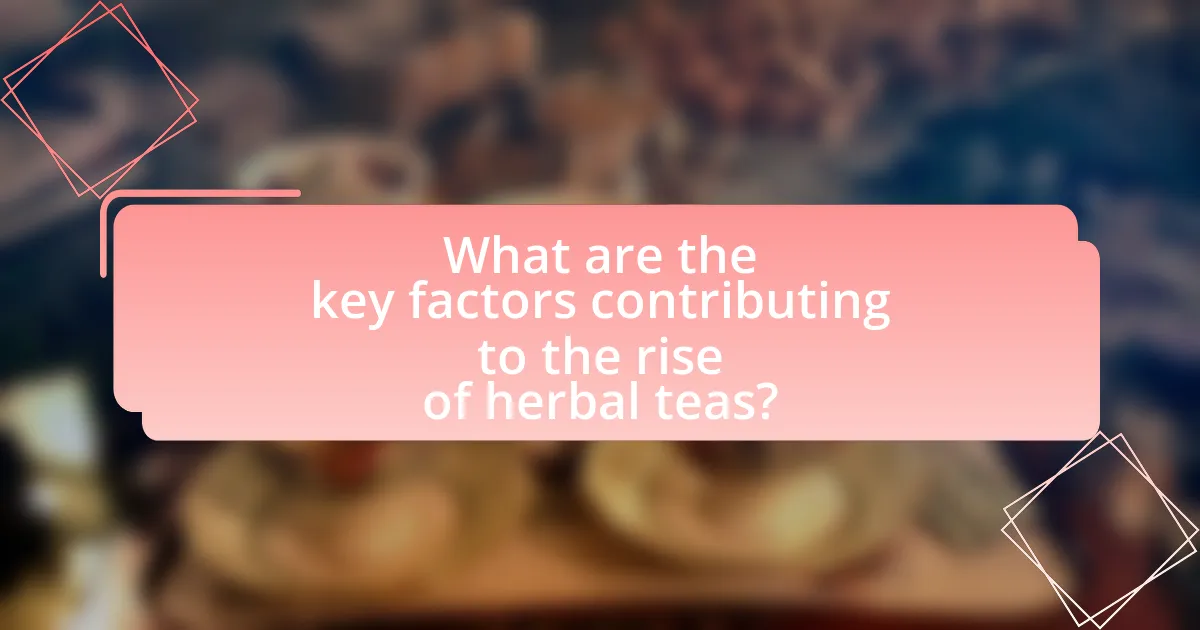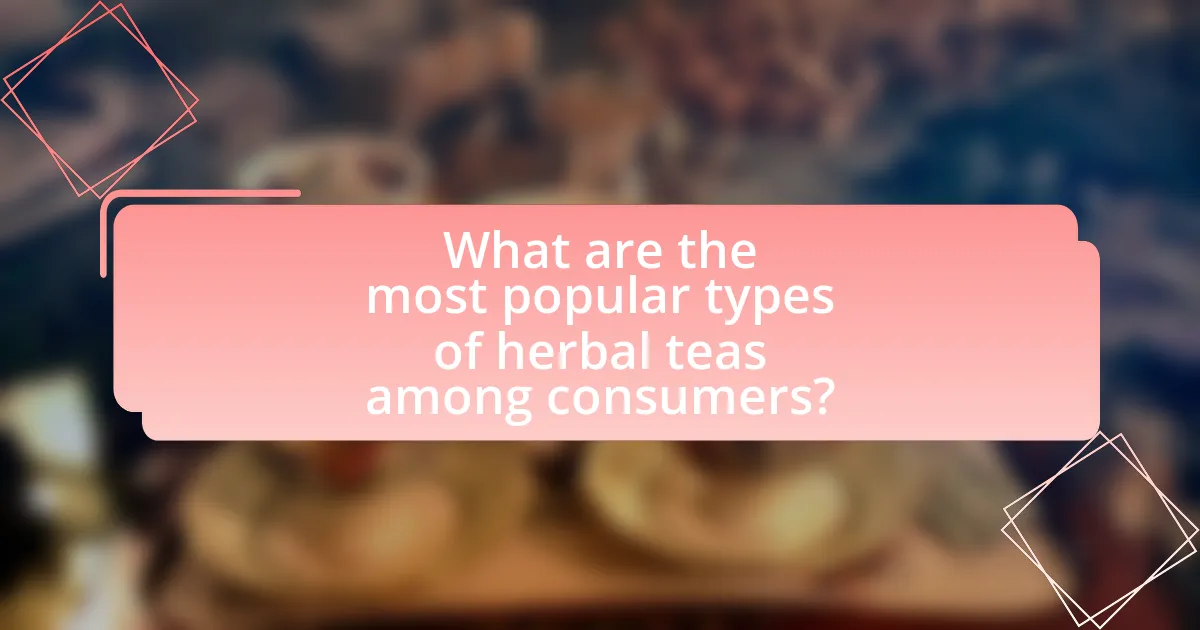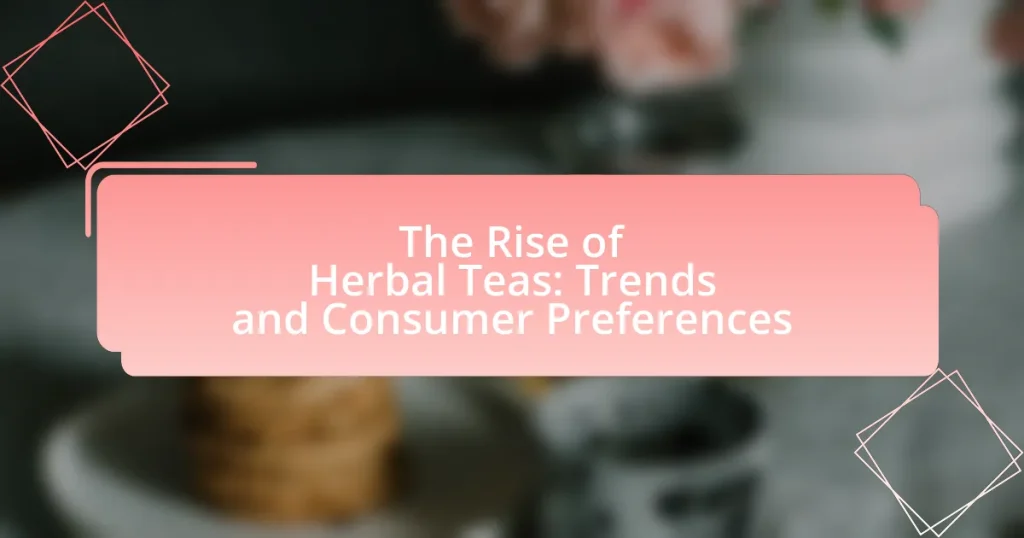The article focuses on the rise of herbal teas, highlighting key factors such as increasing health consciousness, the popularity of natural products, and diverse flavor offerings that contribute to their growing demand. It examines shifts in consumer preferences, particularly among younger demographics, and the impact of health and wellness trends on herbal tea consumption. Additionally, the article discusses marketing strategies, regional variations in preferences, and the challenges brands face in meeting consumer demands, including supply chain issues and quality control measures. Overall, it provides a comprehensive overview of the trends shaping the herbal tea market and the factors influencing consumer choices.

What are the key factors contributing to the rise of herbal teas?
The key factors contributing to the rise of herbal teas include increasing health consciousness among consumers, the growing popularity of natural and organic products, and the diverse range of flavors and benefits offered by herbal teas. Health-conscious consumers are increasingly seeking alternatives to sugary beverages, leading to a surge in demand for herbal teas known for their potential health benefits, such as improved digestion and relaxation. Additionally, the trend towards natural and organic products has made herbal teas appealing, as they are often perceived as healthier options compared to traditional teas or soft drinks. Market research indicates that the global herbal tea market is projected to grow significantly, driven by these consumer preferences and the expanding variety of herbal blends available.
How have consumer preferences shifted towards herbal teas?
Consumer preferences have shifted towards herbal teas due to increasing health consciousness and a growing interest in natural remedies. This trend is evidenced by a report from Grand View Research, which indicates that the global herbal tea market is expected to reach $4.5 billion by 2027, growing at a CAGR of 5.5%. Additionally, surveys show that consumers are increasingly seeking caffeine-free alternatives and beverages with functional health benefits, such as improved digestion and relaxation, which herbal teas provide. This shift reflects a broader movement towards wellness and holistic health, influencing purchasing decisions in the beverage sector.
What demographic trends are influencing herbal tea consumption?
Demographic trends influencing herbal tea consumption include an increasing preference among younger consumers, particularly millennials and Gen Z, who prioritize health and wellness. This age group is more likely to seek out natural and organic products, driving demand for herbal teas known for their health benefits. Additionally, the growing awareness of dietary restrictions and the rise of veganism and plant-based diets contribute to the popularity of herbal teas, as they align with these lifestyle choices. According to a report by Grand View Research, the herbal tea market is projected to grow significantly, reflecting these demographic shifts and preferences for healthier beverage options.
How do health and wellness trends impact herbal tea popularity?
Health and wellness trends significantly enhance the popularity of herbal tea by aligning with consumer preferences for natural remedies and holistic health. As more individuals seek alternatives to conventional medicine, the demand for herbal teas, known for their perceived health benefits such as improved digestion, stress relief, and immune support, has surged. According to a report by Grand View Research, the global herbal tea market was valued at approximately $2.5 billion in 2020 and is expected to grow at a compound annual growth rate of 5.5% from 2021 to 2028, reflecting the increasing consumer inclination towards health-conscious choices. This trend is further supported by the rise of social media influencers promoting herbal teas as part of a healthy lifestyle, thereby driving awareness and consumption.
What role does marketing play in the rise of herbal teas?
Marketing plays a crucial role in the rise of herbal teas by effectively promoting their health benefits and lifestyle appeal. Through targeted advertising campaigns, brands highlight the natural ingredients and wellness aspects of herbal teas, which resonate with health-conscious consumers. For instance, the global herbal tea market was valued at approximately $2.5 billion in 2020 and is projected to grow significantly, driven by marketing strategies that emphasize organic and functional benefits. This strategic positioning not only attracts new customers but also fosters brand loyalty among existing consumers, further contributing to the overall growth of the herbal tea market.
How are brands positioning herbal teas in the market?
Brands are positioning herbal teas in the market by emphasizing health benefits, sustainability, and unique flavor profiles. For instance, many brands highlight the wellness aspects of herbal teas, such as their potential to aid digestion, reduce stress, and boost immunity, which appeals to health-conscious consumers. Additionally, brands are increasingly focusing on sustainable sourcing and eco-friendly packaging to attract environmentally aware customers. According to a report by Grand View Research, the global herbal tea market is expected to reach $3.5 billion by 2025, indicating a growing consumer preference for these products. This trend is further supported by the rise of specialty blends and artisanal offerings that cater to diverse taste preferences, enhancing brand differentiation in a competitive market.
What marketing strategies are most effective for promoting herbal teas?
Effective marketing strategies for promoting herbal teas include leveraging social media marketing, influencer partnerships, and educational content. Social media platforms like Instagram and Facebook allow brands to visually showcase their products and engage with health-conscious consumers. Influencer partnerships can amplify brand reach, as influencers often have dedicated followings interested in wellness and natural products. Additionally, providing educational content about the health benefits and uses of herbal teas can establish authority and attract consumers seeking natural remedies. According to a report by Grand View Research, the global herbal tea market is expected to reach $3.5 billion by 2025, indicating a growing consumer interest that can be tapped into through these strategies.

What are the most popular types of herbal teas among consumers?
The most popular types of herbal teas among consumers include chamomile, peppermint, hibiscus, and rooibos. Chamomile tea is favored for its calming effects and is often consumed before bedtime. Peppermint tea is popular for its refreshing flavor and digestive benefits. Hibiscus tea is appreciated for its tart taste and potential health benefits, including lowering blood pressure. Rooibos tea, known for its rich flavor and antioxidant properties, has gained popularity as a caffeine-free alternative. These preferences are supported by market research indicating a growing trend towards herbal tea consumption, with a significant increase in sales over recent years.
Which herbal tea varieties are trending right now?
The herbal tea varieties currently trending include chamomile, hibiscus, and matcha-infused blends. Chamomile is favored for its calming properties, while hibiscus is popular for its tart flavor and health benefits, including lowering blood pressure. Matcha-infused herbal teas combine the antioxidant properties of matcha with various herbs, appealing to health-conscious consumers. These trends are supported by market research indicating a growing consumer preference for wellness-oriented beverages, with herbal tea sales increasing by 20% in the past year according to industry reports.
What health benefits are associated with popular herbal teas?
Popular herbal teas offer various health benefits, including improved digestion, enhanced relaxation, and antioxidant properties. For instance, chamomile tea is known for its calming effects, which can help reduce anxiety and promote better sleep. Peppermint tea aids digestion and alleviates headaches, while hibiscus tea is rich in antioxidants and may help lower blood pressure. Research published in the Journal of Nutrition indicates that the antioxidants in herbal teas can combat oxidative stress, supporting overall health.
How do flavor profiles influence consumer choices in herbal teas?
Flavor profiles significantly influence consumer choices in herbal teas by affecting taste preferences and perceived health benefits. Consumers often select herbal teas based on specific flavors that align with their personal tastes, such as fruity, floral, or spicy notes. Research indicates that flavor preferences are closely tied to individual experiences and cultural backgrounds, which shape the appeal of certain herbal blends. For instance, a study published in the Journal of Food Science found that consumers are more likely to choose herbal teas with flavors they associate with positive memories or health benefits, such as chamomile for relaxation or peppermint for digestion. This connection between flavor and consumer choice underscores the importance of flavor profiles in the marketing and formulation of herbal teas.
What are the emerging trends in herbal tea consumption?
Emerging trends in herbal tea consumption include a growing preference for functional blends that promote health benefits, such as stress relief and improved digestion. Consumers are increasingly seeking organic and sustainably sourced ingredients, reflecting a broader trend towards health-conscious and environmentally friendly choices. Additionally, the rise of online retail and subscription services has made herbal teas more accessible, allowing consumers to explore diverse flavors and blends from around the world. According to a report by Grand View Research, the global herbal tea market is expected to grow at a compound annual growth rate of 5.5% from 2021 to 2028, indicating a significant shift in consumer preferences towards herbal options.
How is sustainability affecting the herbal tea market?
Sustainability is significantly influencing the herbal tea market by driving consumer preferences towards eco-friendly and ethically sourced products. As consumers become more environmentally conscious, they increasingly seek herbal teas that are produced using sustainable farming practices, which often include organic cultivation and fair trade certifications. According to a 2021 report by Grand View Research, the global herbal tea market is projected to reach $3.8 billion by 2027, with sustainability being a key factor in this growth, as 66% of consumers are willing to pay more for products that are environmentally friendly. This shift is prompting brands to adopt sustainable practices in their supply chains, from sourcing raw materials to packaging, thereby enhancing their market appeal and aligning with consumer values.
What innovations are being introduced in herbal tea products?
Innovations in herbal tea products include the introduction of functional blends that target specific health benefits, such as stress relief, digestion support, and immune enhancement. Companies are increasingly using adaptogenic herbs like ashwagandha and reishi mushrooms to create blends that cater to wellness trends. Additionally, advancements in packaging technology, such as biodegradable tea bags and single-serve pods, are being implemented to enhance convenience and sustainability. Research indicates that the global herbal tea market is projected to grow significantly, driven by these innovations and changing consumer preferences towards healthier beverage options.

How do consumer preferences vary across different regions?
Consumer preferences for herbal teas vary significantly across different regions due to cultural influences, health trends, and local availability of ingredients. For instance, in North America, there is a growing trend towards wellness and health-conscious choices, leading to increased demand for herbal teas that promote relaxation and health benefits, such as chamomile and peppermint. In contrast, in Asia, traditional herbal teas like green tea and ginseng are more prevalent, reflecting long-standing cultural practices and beliefs in their health benefits. Additionally, a study by the Tea Association of the USA indicates that 87% of Americans drink herbal tea, with preferences leaning towards fruity and floral flavors, while in Europe, particularly in countries like Germany and the UK, herbal teas often include a variety of blends that emphasize digestive health. This regional variation highlights how local customs and health trends shape consumer choices in the herbal tea market.
What regional differences exist in herbal tea consumption?
Herbal tea consumption varies significantly across regions due to cultural preferences, availability of local herbs, and health trends. In Asia, particularly in countries like China and Japan, herbal teas such as chrysanthemum and matcha are popular, often consumed for their health benefits and traditional practices. In contrast, Western countries, especially in North America and Europe, have seen a rise in herbal tea consumption driven by wellness trends, with blends like chamomile and peppermint being favored for their calming effects. According to a report by Grand View Research, the global herbal tea market is expected to grow, with North America and Europe leading in consumption due to increasing health consciousness and demand for natural products.
How do cultural factors influence herbal tea preferences?
Cultural factors significantly influence herbal tea preferences by shaping the types of herbs used, preparation methods, and consumption rituals. For instance, in Asian cultures, herbal teas like jasmine or ginseng are favored for their perceived health benefits and traditional significance, while in Western cultures, chamomile and peppermint are popular for their soothing properties. Research indicates that cultural beliefs about health and wellness directly affect these preferences, as seen in a study published in the Journal of Ethnopharmacology, which highlights how traditional practices and local flora dictate herbal tea choices in different regions.
What are the most popular herbal teas in specific regions?
The most popular herbal teas vary by region, with chamomile being favored in Europe, peppermint in North America, and rooibos in South Africa. Chamomile tea, known for its calming effects, is widely consumed in countries like Germany and the UK, where it has a long history of use for relaxation and sleep aid. In North America, peppermint tea is popular for its refreshing flavor and digestive benefits, often enjoyed as a caffeine-free alternative to traditional teas. Rooibos tea, native to South Africa, is celebrated for its rich flavor and antioxidant properties, making it a staple in South African households. These preferences reflect cultural practices and health trends associated with herbal tea consumption in each region.
What challenges do herbal tea brands face in meeting consumer demands?
Herbal tea brands face significant challenges in meeting consumer demands, primarily due to increasing competition and the need for product differentiation. The market for herbal teas has grown rapidly, with a projected CAGR of 6.5% from 2021 to 2026, leading to a saturated landscape where brands must innovate to stand out. Additionally, consumers are increasingly seeking transparency regarding sourcing and health benefits, which requires brands to invest in quality assurance and clear labeling. Furthermore, fluctuating raw material prices and supply chain disruptions can hinder consistent product availability, complicating brands’ ability to meet consumer expectations for quality and reliability.
How do supply chain issues affect herbal tea availability?
Supply chain issues significantly reduce the availability of herbal tea by disrupting the sourcing, production, and distribution processes. For instance, delays in shipping and transportation can lead to shortages of raw materials, such as herbs and spices, which are essential for producing various herbal tea blends. According to a report by the Food and Agriculture Organization, disruptions in global supply chains during events like the COVID-19 pandemic resulted in a 20% decrease in the availability of certain herbal ingredients. Additionally, increased costs of logistics and transportation can lead to higher retail prices, further limiting consumer access to herbal teas.
What quality control measures are necessary for herbal tea products?
Quality control measures necessary for herbal tea products include rigorous testing for contaminants, adherence to Good Manufacturing Practices (GMP), and proper labeling. Testing for contaminants such as pesticides, heavy metals, and microbial pathogens ensures safety and compliance with health regulations. Adhering to GMP ensures that the production process maintains high standards of hygiene and quality, which is critical in the herbal tea industry. Proper labeling, including accurate ingredient lists and health claims, is essential for consumer transparency and regulatory compliance. These measures collectively help maintain product integrity and consumer trust in the growing herbal tea market.
What practical tips can consumers follow when choosing herbal teas?
Consumers should consider the quality, ingredients, and sourcing of herbal teas when making their selections. High-quality herbal teas often come from reputable brands that provide clear information about their sourcing practices and ingredient origins. For instance, consumers should look for teas that are organic and free from artificial additives, as these factors can significantly impact both flavor and health benefits. Additionally, checking for certifications, such as USDA Organic or Fair Trade, can ensure that the herbal tea meets certain quality standards. Research indicates that herbal teas can vary widely in their health benefits depending on the specific herbs used; thus, consumers should familiarize themselves with the properties of different herbs to choose those that align with their health goals.


